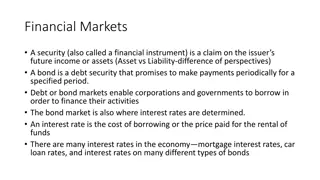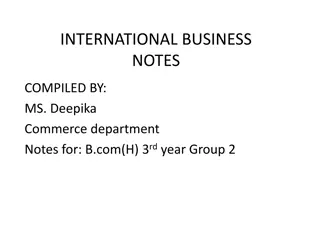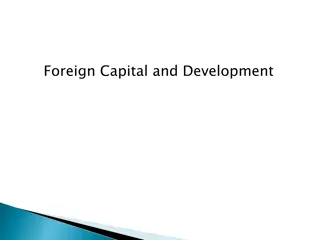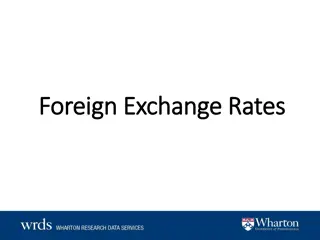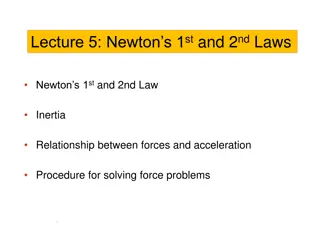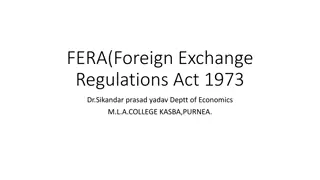Understanding Foreign Exchange Rates and Market Forces
Foreign exchange rate is the rate at which one country's currency is converted into another's, reflecting purchasing power. The rate is determined by demand and supply in the foreign exchange market, influenced by factors like imports, exports, investments, and speculation. Equilibrium rate is reached where demand meets supply. The Purchasing Power Parity theory explains exchange rate determination based on price levels in different countries.
- Foreign Exchange Rates
- Market Forces
- Currency Exchange
- Purchasing Power Parity
- Exchange Rate Determination
Download Presentation

Please find below an Image/Link to download the presentation.
The content on the website is provided AS IS for your information and personal use only. It may not be sold, licensed, or shared on other websites without obtaining consent from the author. Download presentation by click this link. If you encounter any issues during the download, it is possible that the publisher has removed the file from their server.
E N D
Presentation Transcript
Unit-2 Foreign Exchange Rate: Foreign exchange rate refers to the rate at which one country s currency is converted into another country s currency. In other words, it is the rate at which one currency is exchanged for another currency. Thus, the rate of exchange between the Indian rupee and the U.S dollar is $1 = 70, It means that we have to pay 70 to obtain $1. Hence, the rate of exchange expresses the external purchasing power of a currency. In the foreign exchange market, the exchange rate of a currency is determined by the forces of demand for and the supply of foreign exchange. The demand for foreign exchange arises from the following: 1. Import of goods and services. 2. Foreign exchange is needed to meet expenditure incurred in foreign tours
3. Foreign exchanged is required for making unilateral transfers like sending gifts to other countries. 4. Investment in foreign countries. It includes, purchase of assets like, land, shares, bonds etc in the foreign countries. Supply of foreign exchange is determined by the following factors: 1. Export of goods and services. 2. Foreign investments in the country. 3. Remittances from abroad. 4. Speculation. Equilibrium rate of exchange: In a free foreign exchange market, the equilibrium rate of exchange is determined by the market forces the demand for and supply of the currencies concerned. The determination of exchange rate with the help of following diagram
y ?1 D S ?2 ?2 ?1 P Rate of exchange N ?1 ?1 ?1 S D ?1 x o M ?2 ?1 Demand and supply of Foreign currency
In the above diagram DD represents the demand curve for foreign exchange, SS represents the supply curve of foreign exchange. At point P , the demand for foreign exchange is equal to it s supply. ON is equilibrium rate of exchange. If the demand for foreign exchange increases the new demand curve will D1D1, assuming that there is no change in the supply of foreign exchange, rate increase to ON2 Similarly, if the supply of foreign exchange remain the same, a fall in the demand for foreign exchange will reduce the exchange rate On the other hand, assuming that the demand for foreign exchange remains the same if its supply increase , the new supply curve will be S1S1. This will lead to a fall in exchange rate from ON to ON1 . It the supply of foreign exchange decreases there will be raise in the exchange rate
Purchasing Power parity theory of exchange rate: The purchase power parity theory try to explain the determination of the exchange rate between the currencies of two countries under the system of inconvertible paper currency standard. This theory was originally stated by Prof Wheatle, but it was popularized and developed by Swedish economist Gustav Cassel. According to this theory The price level and the change in the price level in different countries determine the exchange rate of those countries currencies According to Cassel, The rate of exchange between two currencies must stand essentially on the quotient of the internal purchasing powers of these currencies . The theory state that, under the system of inconvertible paper currency standard, the exchange rate between the currencies of two countries reflects the parity or equality of the purchasing power of respective currencies. There are two version of the P.P.P theory, they are
1. Absolute version: According to this version, exchange rate is determined at that point at which the internal purchasing power of currencies of two countries are equal. For eg: If a particular commodity calculator costs $10 in USA and 100 in India The exchange rate between US dollar and Indian rupee will be: $1=10 At this rate, exchange rate will be in equilibrium. It can be stated as follows: R=??.?? ??.?? Where, R= Rate of exchange Pa= Prices in country a Pb = Prices in country b Qo = Corresponding weights
2. Relative version: The relative version of the theory says that changes in the exchange rate are due to the changes in the purchasing powers of the currencies. In other words, changes in the internal value of money bring about changes in the external value of the currencies concerned In the relative version, some past exchange rate is assumed to be the equilibrium rate and it adopted as the base rate. As changes in the purchasing power can be measured by changes in the indices of domestic prices of the countries concerned. Changes in the equilibrium rate can be measured by the ratios of prices indices of the respective countries. Changes in exchange rate can be calculated by using the following formula:
New Exchange Rate = Old Exchange Rate Domestic price index (In base period) Domestic price index (In current period) X Foreign price Index(In current period) Foreign price Index(In base period X ?1= ?0 ??0 ??1 ??0 ??1 Suppose, old exchange rate between India and USA was $1= 10, if the price index increases to 150 in India and 300 in USA the new exchange rate will be ?1= 10 100 150 300 100 $1 = 20 (?1=20)
The purchase power parity theory can be explained with the help of following diagram ?1 D Y S ?1 Commodity export point Exchange Rate Purchasing power parity R S ?1 ?1 D Commodity import point X O Q Amount of foreign Exchange
It is clear form the above diagram the P.P.P curve is fluctuating in character. In addition the curves the commodity exports and commodity import points also fluctuates. DD is the demand curve of foreign exchange and SS is the supply of foreign exchange. The interaction of these two curves determined the market rate of exchange. OR is the market rate of exchange and OQ represents the quantity of foreign exchange demanded and supplied curves. ?1?1 and S1S1 shows shifts in demand and supply curves respectively due to changes in the quantity demanded and supplied. This will leads to fluctuations in the market rate of exchange around the normal rate of exchange. The normal rate of exchange is determined by the purchasing power parity.
Limitations: 1. One sided: This theory is one sided because it considers supply of foreign exchange only. In the process it ignores completely the demand side of the theory. 2. Ignores capital Movements: The theory considers the movements of goods only and neglected capital movements. 3. Ignores quality of goods: This theory does not considered differences in quality of goods between the different countries. 4. Neglect of invisible goods: The theory does not take into account trade in invisible goods, which also forms a part of international trade.
5. Difficulties of Index Number: In order to measure purchasing power, price index numbers are used. But there are many conceptual and practical difficulties in the construction of price index numbers. 6. Long Run theory only: The PPP theory applicable only for a long run. It is unsuitable to explain short term changes in the exchange rate. 7. Narrow view: This theory does not consider the price of commodities in international market which are determined on the basis of the cost of production, the cost of transportation, speculation, tariff duties etc 8. Static theory: This PPP theory seeks to determine the equilibrium rate of exchange under static conditions. Hence, it fails in the real dynamic nature.
Balance of Payment Theory of exchange rate: The balance of payment theory of exchange rate is also known as the General equilibrium theory of exchange rate. It is also called as demand and supply theory of exchange rate. According to this theory, the exchange rate of a countries currency is determined by it s balance of payment situation or position. According to this theory, In a free market situation, the exchange rates are determined by the market forces, demand and supply of foreign exchange. The theory states that, the rate of exchange basically relates to the position of balance of payments of the country. A fabourable balance of payments leads to an appreciation in the external value of the currency of the country.
Unfavourable balance of payments causes a depreciation of the external value of the currency of the country. Balance of payment is a systematic record of all international payments to various international transactions such as imports, exports, investment and other commercial and speculative transactions. The balance of payments includes all payments made by the foreigners to the country as well as all payment made by a country to the foreigners The incoming payments are credits and outgoing payments are debits. The credits in balance of the payments or the export items constitute the supply of foreign exchange. The supply of foreign exchange is made by the exporting countries. On the other hand, the debits in the balance of payments or import items constitute the demand for foreign exchange. The demand for foreign exchange arise from the importing countries.
According to this theory, The balance of payment situation of a country determined the demand for and supply of foreign exchange in the country. A surplus or favourable balance of payment increases supply of foreign exchange and decreases demand for it. This increases the value of domestic currency against foreign currency. On the other hand, a deficit or unfavourable balance of payments decrease the supply of foreign exchange and increases demand currency against foreign currency. Suppose, the country experience deficit in its balance of payments, demand for foreign exchange increases and supply of foreign exchange decrease This leads to an increase in the exchange rate. This can be shown in the following diagram
Deficit Balance of payment D1 D y S1 S Foreign Exchange rate R1 E1 R E S1 D1 D S o x Demand and Supply of foreign exchange In the above diagram increase in demand for foreign exchange is shown by shift in demand curve to the right from DD to D1D1 and decrease in the supply of foreign exchange is shown by a shift in the supply curve to the left. The new demand curve D1 D1 and new supply curve interest at point E1, then the new equilibrium exchange rate will be R1.
On the other hand, if the country experiences a surplus in its balance payments, exchange rate will decreases. Demand for foreign exchange decreases and supply of foreign exchange increase this leads to a decrease in exchange rate. This can be shown in following diagram.
D Y D2 S S2 Foreign Exchange Rate R E R2 E2 S D S2 D2 O X Demand and supply of foreign exchange In the above diagram, decrease in the demand for foreign exchange is shown by a shift in the demand curve to the left and increase in the supply of foreign exchange is shown by a shift in supply curve to the right. The new demand curve D2D2 and the new supply curve S2S2 intersect at point E2 then the new equilibrium exchange rate will be R2.
Thus, According to the balance of payment theory of exchange rate, exchange rate is influenced by the balance payment position of the country. A deficit in balance of payment leads to increase in exchange rate ( depreciation of the currency) A surplus in balance of payment leads to decrease in exchange ( appreciation of the currency) Merits: 1. This theory is wider in scope because, it takes into account all the items that enter into balance of payment of a country. 2. It is similar to the general theory of value because it considered the market forces demand and supply. 3. This theory suggest that the disequilibrium in the balance of payments of a country can be corrected by making appropriate adjustments in the rate of exchange. 4. This theory is more realistic because, the domestic price of foreign currency is a function of many variables.
Limitations: 1. It has been argued that exchange rate also influence the balance of payments. 2. It is based on the realistic assumption of the existence of perfect competition. 3. It wrongly assumes that the demand for imports is perfectly price inelastic. 4. It assumes that there is no connection between rate of exchange and internal price level. 5. This theory fails to explain the basic value incorporated currencies
INDIAN RUPEE EXCHANGE RATES TABLE Indian Rupee 1.00 INR 1.00 INR US Dollar 0.014142 70.709408 Euro 0.012675 78.898454 British Pound 0.010859 92.086394 Australian Dollar 0.020462 48.872223 Canadian Dollar 0.018446 54.213097 Singapore Dollar 0.019036 52.531886 Swiss Franc 0.013628 73.376111 Malaysian Ringgit 0.057589 17.364407 0.643035 1.555126 Japanese Yen Chinese Yuan Renminbi 0.097450 10.261684
Argentine Peso Australian Dollar Bahraini Dinar Botswana Pula Brazilian Real British Pound Bruneian Dollar Bulgarian Lev Canadian Dollar Chilean Peso Chinese Yuan Renminbi Colombian Peso Croatian Kuna Czech Koruna Danish Krone Emirati Dirham Euro Hong Kong Dollar Hungarian Forint Icelandic Krona Indonesian Rupiah 0.846821 0.020462 0.005318 0.151336 0.059084 0.010859 0.019036 0.024789 0.018446 10.970861 0.097450 46.686972 0.094372 0.318099 0.094717 0.051938 0.012675 0.109897 4.220304 1.734368 193.534778 1.180887 48.872223 188.056935 6.607833 16.925114 92.086394 52.531886 40.340139 54.213097 0.091151 10.261684 0.021419 10.596355 3.143676 10.557724 19.253753 78.898454 9.099406 0.236950 0.576579 0.005167
Causes of fluctuation in exchange rate: 1. Balance of payment position: Foreign exchange rate is determined by countries balance of payment position. If exports are more than imports than demand for foreign exchange will be less than supply of foreign exchange. As a result, domestic currency will be appreciate against foreign currencies. On the other hand, if imports are more than export, then demand for foreign exchange more than supply of foreign exchange. Hence domestic currency will depreciate against foreign currency. 2. Inflation: The rate of inflation in the country also influences the exchange rate. A high rate of inflation in the country makes its goods costlier to the foreigners, as a result its exports decline. But foreign goods became cheaper to the domestic people, Hence import increases. This increases the demand for foreign exchange and decreases its supply and leads to the depreciation of the currency.
3. Interest rates: The rate of interest also effects on exchange rate. If the rate of interest increases in a country, there will be an inflow of capital into the country. This increases the demand for it s currency. As a result, the domestic currency will appreciate. On the other hand, a low rate of interest in the country, will leads to outflow of capital and the domestic currency will depreciate. 4. Capital movement: The inflow and outflow of capital will bring about changes in the exchange rate. The foreign direct investment, port folio investment, lending and borrowing etc. will influence the rate of exchange. An inflow of foreign capital strengthen the domestic currency and an outflow of capital weakens the currency.
5. Changes in Money supply: When the supply of money in a country increases, it leads to a rise in the price level and therefore it creates inflation. As a result the exports of a country decreases and increase in it s exchange rate. The excess supply of money in the economy will lead to outflow of money and this directly influence the exchange rate. 6. National income: Change in the national income of country will have effects on the exchange rate. It national income increases, the purchasing power of the people increases, leading to an increase in the demand for goods. Its domestic supply of goods is not adequate, imports increases and an increase in the rate of exchange. 7. Political Factors: It also cause changes in exchange rates. Existence of peace and security, law and order, political stability etc will induce confidence in the investors and encourage inflow of capital. This will have favourable effect on the exchange rate.
On the other hand, political instability changes in govt or leadership, unfavourable law and order, civil war etc. will lead to outflow of capital. This will have negative effect on exchange rate. 8. Speculation: It also influence on the exchange rate. A large scale purchase or sale of foreign exchange by speculators with the expectations of a fall or rise in exchange rate causes the exchange rate to fluctuate. If a country s currency value is expected to rise, investors will demand more of that currency in order to make profit in near future. As a result, the value of the currency will rise due to the increase in the demand. With this increase in currency value leads to rise in exchange rate. Thus, speculative activity bring about wide fluctuations in rechange rate 9. Government Intervention: When the market forces do not influence the exchange rate in country s favour, then its monetary authorities intervene in the foreign exchange market through buying and selling of foreign currency and influence the exchange rate. ********** ********* ************
Fixed Exchange Rate System: Under this system, countries keep their currencies at a fixed rate and change their value only when the economic situation requires. In this system, govt or the central bank keeps the exchange rate of its currency fixed through a policy of intervention in the foreign exchange market. Govt have to maintain sufficient reserves of foreign exchange. Under the gold standard, the value of the currency was fixed as the value of gold of definite weight and fineness. Under the paper currency system, the exchange rate was determined by relative purchasing power of the currencies. Arguments for Fixed exchange rate system. 1. Promotion of International Trade. A system of fixed exchange rates contributes to the promotion of international trade. This is because of the certainty associated with the exchange rate. Exporters and importers will have a correct knowledge of amount they will receive or they will have to pay in terms of home currency.
2. Encouragement to International investment: Under this system , international investment will be promoted because investors will be free from uncertainty and risk of fluctuation in exchange rate 3. Correction of balance of payment disequilibrium (deficit) : Fixed exchange rates help the less-developed countries to correct the deficits in their balance of payments. This exchange rate help to prevent continuous depreciation of the external value of the currencies. 4. Prevention of the outflow of capital: Stability in exchange rate will helps to prevent the outflow of capital from the country. Frequent flow of capital will have destabilizing effects of in exchange rate. 5. Prevention of speculation: A stable exchange rate system eliminates speculation in the foreign exchange market. It avoids the speculation and helps in orderly growth of international trade.
6. Development and growth: Exchange rate stability is necessary for development and growth of foreign trade. If exchange rate stability is not assured, exporter will be uncertain about the amount they will receive and importers will be uncertain about the amount they will have to pay. 7. Growth of international financial markets: A stable exchange rate system is also necessary for the growth of international money and capital market. Due to uncertainties in the exchange market, individuals, Firms and institutions may not involved in lending and borrowing activities in the money and capital market
Arguments against Fixed exchange rate system: 1. Sacrifice of Independent economic policy: Fixed exchange rate policy implies the abandonment of independent domestic economic policy aimed at price stability, full employment, etc. This policy does not indicate the real economic condition of the economy. 2. Need to maintain huge foreign exchange resources: In this system, the govt has to maintain large reserves of foreign currencies. This imposes heavy burden on the monetary authorities for managing foreign exchange reserves. 3. Needs for exchange control measures: The success of a fixed exchange rate system requires the existence of an efficient exchange control mechanism. The central bank of a country adopt various exchange control measures to stablise the rate of exchange. But exchange controls have their own adverse effects.
4. Unsuitable for long-run: A policy of a fixed exchange rate system cannot be pursued for long-period of time. This is due to the changing international economic conditions. 5. Cost price relationship: It has been argued that, a system of fixed exchange rates doesn't reflects the present and true cost-price relationship between countries because they are based on past rates. 6. Difficult in the adjustments of balance of payments: Adjustments in the balance of payment of the country are difficult because there is less scope for changes in the exchange rate system. 7. Not permanently fixed: Pegged exchange rate system are not permanently fixed . Hence, they may not promote long-term international investment.
Flexible exchange rate system: [Floating Exchange rate system] Under this system, exchange rates are freely determined in open foreign exchange market on the basis of the interaction of the market forces the demand for and supply of foreign exchange. In this system, exchange rates are determined on the basis of balance of payment position. A surplus in the balance of payment will create an excess demand for the country s currencies and exchange rate will tend to raise. On the other hand, a deficit in the balance of the payments, will create excess supply of the country s currency and the exchange rate will tend to decrease.
Case for flexible exchange rates (Merits): 1. Smooth adjustment in balance of payment: Under this system, the adjustment in the balance of payments are easier as compared with the fixed exchange rate system. In this system exchange rates are based on the market forces demand and supply of foreign exchange. 2. Independent Economic policy: A flexible exchange rate system provide larger degree of autonomy in respects of domestic economic policy. So that, it is easy to adjust with the domestic problems. This policy pursue independent economic policy. 3. No trade restrictions and exchange controls measures: A system of flexible exchange rates does not require the introduction of complicated and expensive trade restrictions and exchange measures.
4. Better liquidity: In this system, there is no need for the country to maintain huge foreign exchange reserves. There is no need for the central bank to interfere in the foreign exchange market. 5. Gains from free-trade: The advantages of free trade could be realized under a system of flexible exchange rates. This is because, there is no need for the imposition of trade restrictions and exchange controls. 6. Better Confidence: Under this system, any adverse situation in the balance of payment is corrected automatically. It increases the confidence of international investors. 7. Cost price-relationship: This system reflect the true cost price relationship between two countries. It facilitates automatic adjustment of the BOP disequilibrium. It establishes the true cost price relationship. 8. Simple System: A system of flexible exchange rates is very simple in it s working. In this system, there is no govt intervention in the foreign exchange market. Exchange rates are adjusted automatically on the basis of demand and supply.
Argument (case) against Flexible exchange rate system: 1 Uncertainty and Risk: In this policy, there will be uncertainty in the exchange rates. The rate of exchange is vary from time to time. Hence, It leads to much risk to the investors. 2. Encourages Speculation: A serious drawback of flexible exchange rate system is the wide spread speculation. Speculation will have a destabilizing effect on international financial system. 3. Inflationary pressure: A system of flexible exchange rates has a inflationary pressure on the economy. When the currency depreciates due to a deficit in the balace of payments, imports will be costlier and leading to inflation. 4. Adverse effects on foreign trade: In this system, the exporters and importers will not be certain about the exchange rate. This will have discouraging effect on international trade.
5. Competitive exchange depreciation: Under this, there is a possibility of countries engaging in competitive depreciation of their currency to capture world market. 6. Absence of stable medium of exchange: A drawbacks of flexible exchange rates is that, it effects the world economy of a stable medium of exchange, unit of account, store of value and standard of deferred payments. It leads to adverse effect on world trade and welfare of the people. ****** ******** ******* ********


